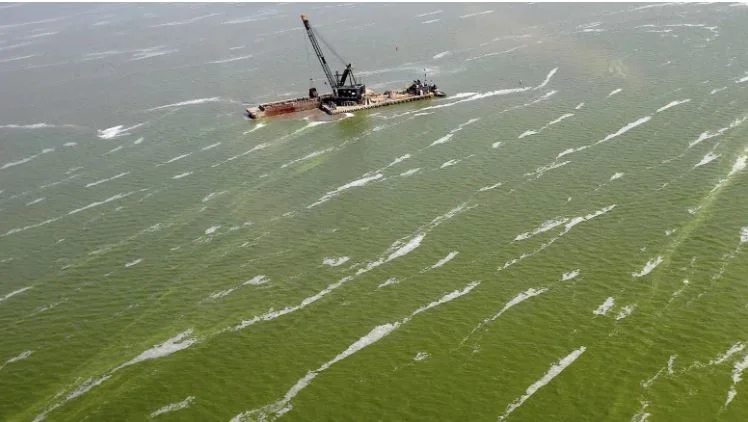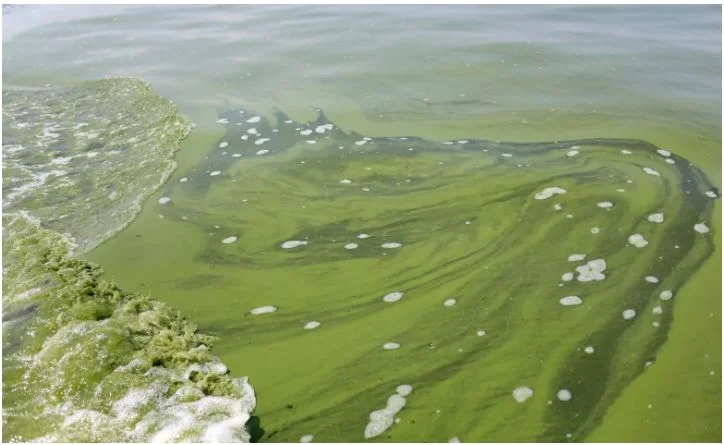Jordan Eleniak, a Métis student who grew up in Lac La Biche, doesn't recall a summer without a blue-green algae bloom. He designed a bacterial fuel cell to help communities forecast them. Blue-green algae are also known as cyanobacteria. Blue-green algae blooms are a natural phenomenon, but when they reach excessive levels, they can become toxic to the environment and to aquatic animals.
Algae blooms behind Regina and Moose Jaw's musty water: Buffalo Pound water treatment plant
Early algae blooms are to blame for the musty water some people are noticing in Regina and Moose Jaw these days, according to experts at the Buffalo Pound water treatment plant, which services both cities. Blair Kardash, the plant's manager of laboratory and research, told CBC News his team first detected the "odour materials" from the growing algae in Buffalo Pound Lake — where the water comes from before it's filtered — at the end of April.
Dead fish in San Francisco area blamed on toxic red tide
“We normally have algae blooms during the summertime. But what’s unusual about this one is how large it is and the fact that there are fish kills,” White said. Most algae blooms end after a week or so. But a triple-digit heat wave forecast for the holiday weekend may help the Bay Area's grow even more, White said. She said that reports of dead fish started coming in last week.
Windsor-Essex County Health Unit issues advisory over blue-green algae
The south shores of Lake St. Clair are under a blue-green algae bloom advisory. The Windsor-Essex County Health Unit issued the warning on Friday, saying that people should avoid swimming if the water looks cloudy or like "green paint or pea soup." "Infants and young children [under age six] should not swim or play in the water. For adults and children six years of age and older, they should swim with caution and rinse off after swimming," the health unit said in a media release.
Halifax approves program to test for contaminants at 74 lakes
A new water quality monitoring program has been approved for the Halifax region that will see 74 lakes sampled beginning in spring 2022. The lakes will be tested for algae blooms and E. coli, as well as phosphorus, chlorophyll and chloride. According to the municipality's manager of environment, the lakes have been chosen based on scientific criteria. "It's based on our current understanding of their vulnerabilities," said Shannon Miedema. "We do have a thousand lakes within our municipal boundaries."
Bad news for fishing: Climate change is sucking the oxygen out of lakes, study suggests
The researchers found that from 1980 to 2017, oxygen levels fell by about five per cent near the surface and 19 per cent in deep waters, they reported in the journal Nature last week. The decline in oxygen levels in lakes is 2.75 to 9.3 times higher than the decline in oxygen in the world's oceans, which has also raised concern among scientists about the health of aquatic life. The fact that water can't hold as much oxygen at warmer temperatures is a main factor in decreasing oxygen levels in both lakes and oceans. When the surface waters warm, they also mix less with deeper waters, disrupting the downward flow of oxygen.
Algae blooms becoming more intense, lasting longer in Qu'Appelle Valley lakes: U of Regina biologist
First Nations leaders, community activists and university scientists say they're growing increasingly worried about the Qu'Appelle Valley chain of lakes, with water quality sometimes dipping below recreational use standards and toxic algae blooms increasing in severity. "We're going to get hit with some wicked blue-green-purple algae if we don't start building policies and protecting our fresh water," said Aura Lee MacPherson, chair of the Calling Lakes Ecomuseum, an advocacy group that works to protect the Lower Qu'Appelle River watershed, in southeastern Saskatchewan.
Conservation authority, farmer discuss soil and water health
Maitland Conservation (MC), formerly Maitland Valley Conservation Authority (MCVA), has been monitoring two agricultural sub-watersheds to address water quality concerns and the effects of farming practices on local water. Ben Van Dieten, Agricultural Stewardship Technician, and Chris Van Esbroeck, Stewardship Services Coordinator of MC, presented their findings to date on these projects, in terms of how and when sediment and nutrients leave the landscape, and the practices they promote to reduce these losses.
Young Innovators: New U of S app tracks causes of algae bloom
A new University of Saskatchewan smartphone app will help farmers and communities identify hotspots of nutrient contamination in freshwaters and possibly predict where algae blooms — slimy, plant-like green organisms that hinder water quality — are likely to grow. “Tracking how and where agricultural nutrients, which help crops grow, may be washed away with rainfalls and snowmelt is a major concern for both researchers and the public, and that’s where our app comes in,” said Environment and Climate Change Canada scientist Diogo Costa.
Winnipeg MP says federal government willing to help tackle Lake Winnipeg pollution
Help could be on the way to update the North End Sewage Treatment Plant and fight pollution in Lake Winnipeg. The Lake Winnipeg Foundation, an environmental non-governmental organization, said the city is the single largest contributor of phosphorus in the lake, at around five per cent. Winnipeg South MP Terry Duguid, parliamentary secretary to the minister of environment and climate change, told 680 CJOB the federal government is willing to do its part to tackle the problem, but the North End plant only serves as a starting point.
U of R researcher finds high municipal water rates becoming a burden on low-income households
With some of the highest municipal water rates in Canada, a University of Regina (U of R) researcher says the city should start thinking about affordability programs for low-income families. “The international benchmarks tell us we should be in trouble now, because people who are living at the Statistics Canada low-income cut off are already paying more than the OECD (Organization for Economic Co-Operation and Development) says they should be paying,” Jim Warren said in an interview Thursday.
Moncton lays groundwork to deal with cyanobacteria in water supply
Moncton plans to spend $6 million this winter to upgrade its water treatment plant, the first phase of a plan to deal with cyanobacteria in the municipal water supply. Cyanobacteria was found in 2017 in the Turtle Creek watershed, the drinking water source for Moncton, Dieppe and Riverview. Cyanobacteria, also known as blue-green algae, can form blooms and produce toxins harmful to humans and animals. The water remains safe to drink and the multimillion dollar upgrades are meant to keep it that way.
'Watching our lake die': Blue green algae fills Lake Winnipeg beaches
Toxic blue green algae blooms are appearing on Lake Winnipeg beaches earlier than normal, as the deadline looms for the City of Winnipeg to come up with a plan to tackle the excessive amount of phosphorus it's pumping into the lake each day. Some residents who live along the lake's shorelines say the bright green goo — which grows because of an excessive amount of phosphorus in the water — is the worst they've seen.
Stopping algae blooms may start on farmlands
A handful of Chatham farms might hold the answer to reducing toxic algae blooms in the Great Lakes. These farms are collecting and analyzing their agricultural runoff, in hope of reducing the amount of phosphorus entering the waterways. It's part of a project, started by two organizations in Spring 2016, which aims to come up with a strategy to deal with toxic algae blooms. Out of that idea for the project — between the Ontario Federation of Agriculture and the Great Lakes and St. Lawrence Cities Initiative — came the Thames River Phosphorus Reduction Collaborative.
Great Lakes are rapidly warming, likely to trigger more flooding and extreme weather
The Great Lakes region is warming faster than the rest of the U.S., a trend that is likely to bring more extreme storms while also degrading water quality, worsening erosion and posing tougher challenges for farming, scientists report. In a report commissioned by the Chicago-based Environmental Law & Policy Center, the annual mean air temperature in the region increased 0.89 C in the periods 1901-60 and 1985-2016 — compared to 0.67 C for the rest of U.S.

















